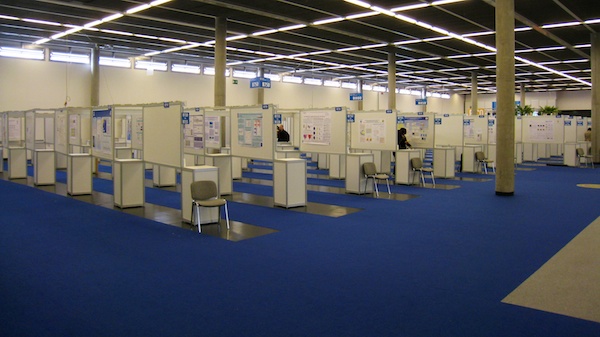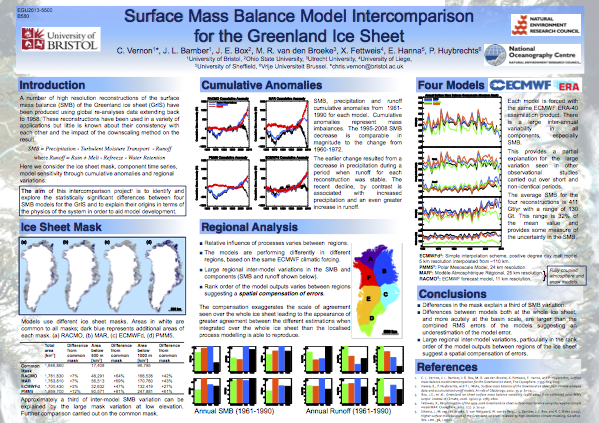I’m on my way home from my first EGU conference, taking a sleeper train from Venice to Cologne, then on to Brussels, to London via Eurostar and finally back to Bristol. It takes 23 hours with fairly slack connections. It’s a lot more civilised than flying and, especially important when attending a geoscience conference, has a lower environmental impact.
Secondly, the session on Blogs and social media in scientific research. This was a panel discussion including two PhD students, a postdoc and a professor. All were passionate about blogging and tweeting their science, highlighting the many benefits; build network of contacts, raise profile, public good, improve communication skills, twitter is friendly place, can approach people, opportunity for collaboration, awareness of job opportunities, keep up with what people are doing before publications, exposure, fun, educational… but also offering some advice. Be professional – more so than in scientific life! Be measured and maintain higher ground, explain concepts carefully, invite contributions but vet them, don’t duck key issues – but don’t get drawn into unwinnable discussions, correct errors, don’t blog primary research before publication, have separate Twitter accounts for professional and personal life, think about what audience what to know and don’t tweet too much!
There are a few Twitter hash tags worth catching up on:
#EGU2013 is the main comment feed
#EGUSMEDIA for discussion arising from the blogging and social media discussion and
#EGUFrack for the fracking debate.
Videos of the press conferences are available here: http://media.egu.eu/press-conferences/
I’m in my tenth year of blogging and I’ve been tweeting for around four years. Social media has been very valuable for me. My main challenge is how to cover my science, along with beekeeping, bicycles, growing, amateur radio etc.
I attended a fairly broad range of sessions, focusing on climate, interglacial climate, arctic climate, snow and ice energy balance and ice shelves but also including energy meteorology, geoenergy and results from Mars. In addition to these conventional sessions, I also attended the great debate on shale gas: to frack or not to frack and another short course on Tipping Points in the Geosciences.A few messages: Greenland did not contribute more than 2m of the 6-8m sea level rise during last inter-glacial according to Dorthe Dahl-Jensen’s work on the NEEM ice core. Katy Pol told us evidence from Antarctic core (EPICA Dome C) suggests a warmer climate (last interglacial) may be more variable than today’s. Contrails reduce solar power by 60% when sun blocked but small enhancement when not actually blocked, net negative effect though, P. Weihs. Alan Robock explained how a 50 nuclear bomb war between India and Pakistan would cause global cooling of ~1.5 C for a decade and devastate agriculture. 4000 bombs (most of them) would cause -8C global cooling, using nuclear weapons would be suicide through starvation/nuclear winter. F. Lott from the MetOffice used event attribution analysis to suggest the East Africa drought in 2011 was more likely as a result of anthropogenic climate change. Arctic sea ice would have reached minimum without ‘The Great Arctic Cyclone of August 2012’, Irina Rudeva. K. Kjeldsen showed how Southern Greenland been losing ice since little ice age but there’s been a factor-2 increase in loss rate in early 21st Century.
Meeting up with friends and colleagues I hadn’t seen for a couple of years was good – but especially valuable was meeting two of my co-authors for the first time. It’s great to finally meet face to face with people I’ve only been working with through email for the last few years. It’s amazing how productive ‘virtual teams’ can be but those 15 minute chats in person are invaluable.
On Thursday I had a poster presentation. We had the opportunity to give a two minute ‘poster flash’ in the main oral session. This worked really well, as it gave us the chance to let everyone know who we were and the main thrust of our work. Here’s the poster I presented:
Surface mass balance model intercomparison for the Greenland ice sheet.
Finally, I’d like to finish with a plug for the conference I’m co-organising in Edinburgh this summer. It’s the Global Energy Systems conference, a three day event examining the challenges facing our energy system in detail including supply side constraints, energy-return, renewable energy and the rate-limit of non-conventional fossil fuel. All issues that will drive future energy prices. We have a really top speaker line up including Sir David King, Lord Ron Oxburgh, Dr. Jeremy Leggett, Prof. Stuart Haszeldine, Dr. Michael Kumhof, Dr Peter Jackson and many more. We still have space for poster presentations, register here.








